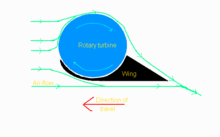FanWing

The FanWing is an aircraft configuration in which a horizontal-axis cross-flow fan is used in close conjunction with a fixed wing. The fan forces airflow over the fixed surface to provide both lift and forward thrust.
Description
The fans extend the full span of the wing from root to end plates and approximately 50% of the wing's chord, from a little to the rear of the leading edge to a wedge-like fairing that forms the trailing edge.
A cylindrical radial turbine resembling the blades of a cylinder mower is embedded in the upper surface of the wing with its axis parallel to the wingspan, leaving approximately 2/3 of the turbine's outer diameter exposed with the remainder being enclosed in a trough formed at the leading edge and terminating in a comma-shaped wedge.
The radial turbine increases the velocity of the airflow over the wing's upper surface independently of the forward motion of the aircraft, so that the fan wing can achieve useful lift at forward speeds lower than the stalling speed for a conventional wing.[1][2][3]
Limitations
Various remote-controlled scale models demonstrated controlled flight but there are negatives compared with normal fixed-wing flying:
- The throttle directly affects the pitch. This means increased throttle can decelerate the aircraft.
- Glide-ratio in case of power-failure is low (about 1:3) but if the rotors are allowed to auto-rotate, it can still glide.
- Previous attempts using the Coanda/Magnus effect failed because the rotating parts caused gyroscopic effects which impaired maneuverability.[4]
Development
The FanWing idea was conceived in 1997 by Patrick Peebles, an American based in the UK, who formed the FanWing Company and applied for patents in countries where aircraft are manufactured. In July 2005 the company announced the first FanWing aircraft was in development in the United Kingdom, having undergone wind tunnel tests and powered model flights. It won SMART awards in 2002 and 2003 and the UK government contributed to development funding.[5]
In May 2007 the developers announced a prototype STOL urban surveillance drone would be built.[6][7] They also announced that a two-seat technology demonstrator was to be flown at AirVenture in Oshkosh, Wisconsin in 2013,[8] but that doesn't appear to have happened. A tail-plane has since been added to the models which has increased the minimum forward speed.[8]
As of 2014 support for wind tunnel tests of a 1.5 meter wing section was being provided through EU sources including €783,000 through the German Aerospace Center.[9]
A freight application has been suggested that would permit STOL operations at night in developed areas.
See also
References & notes
- ↑ "It looks like a lawnmower, was designed in a kitchen - but it could revolutionise aviation" The Independent, 11 November 2002
- ↑ "2004 Year In Ideas: The FanWing" The New York Times Magazine, 12 December 2004
- ↑ "More-powerful Fanwing set to fly" Flight International Magazine, November 2004
- ↑ J Seifert: 'A review of the Magnus effect in Aeronautics'
- ↑ "Innovate UK is an Executive non-departmental public body, sponsored by the Department for Business, Innovation & Skills.". Innovate UK - the UK's innovation agency. GOV. UK. Retrieved 3 May 2016.
- ↑ FanWing UAV gets airborne after ground roll of only 1m Rob Coppinger, Flight International 01/05/07, Accessed August 2007.
- ↑ FANWING - The Fixed-Wing Contender in the Rotorcraft Segment, Frost and Sullivan, 10 Jan 2011
- 1 2 Could FanWing go from LSA to heavy lifter?, Robert Coppinger, Aircraft Owners and Pilots Association, November 22, 2011. Accessed June 2012
- ↑ Warwick, Graham. "Intermodal-container Air Cargo Concepts Attract Interest (Cargo Cult)" Aviation Week & Space Technology page 15, 25 August 2014. Accessed: 26 August 2014.
- 'Flugzeuge mit Walzenflügeln'. Dipl. -Ing. H. J. Lindstaedt (Lindstädt), Luftfahrt International 22, pag. 3415-3430, Mittler & Sohn GmbH, Herford, Germany, 1987. ISBN 3 87547 185 7
External links
![]() Media related to FanWings at Wikimedia Commons
Media related to FanWings at Wikimedia Commons
- FANWING Ltd company website
- Slashdot: Fanwing Planes?
- Image of fan wing remote controlled development model
- Artists concept of two-seat technology demonstrator
- night freighter concept